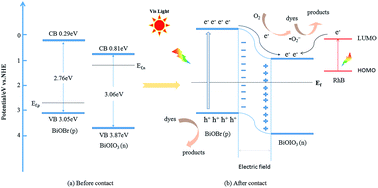Facile fabrication of BiOIO3/BiOBr composites with enhanced visible light photocatalytic activity
Abstract
BiOIO3/BiOBr composite photocatalysts were successfully fabricated through a hydrothermal and subsequent chemical precipitation method. The as-prepared samples were characterized by X-ray diffraction (XRD), scanning electron microscopy (SEM), transmission electron microscopy (TEM), high-resolution transmission electron microscopy (HRTEM), UV-vis diffuse reflectance spectroscopy (UV-vis DRS), Brunauer–Emmett–Teller (BET) surface area, photoluminescence (PL) and photocurrents to investigate the structures, crystallinity, morphology and optical properties. Compared with pure BiOIO3 and BiOBr, BiOIO3/BiOBr composites exhibited significantly enhanced visible light photocatalytic activity towards the degradation of organic dyes. Specifically, the 1I/6Br composite was found to show the maximum value of the activity and maintained good stability in the recycling process. The enhanced photocatalytic activity could be attributed to the formation of a p–n heterojunction between BiOIO3 and BiOBr, which resulted in the effective separation and transfer of photogenerated electron–hole pairs. Moreover, the active species trapping experiment confirmed that ˙O2− and h+ were the main active species during the photocatalytic process.


 Please wait while we load your content...
Please wait while we load your content...